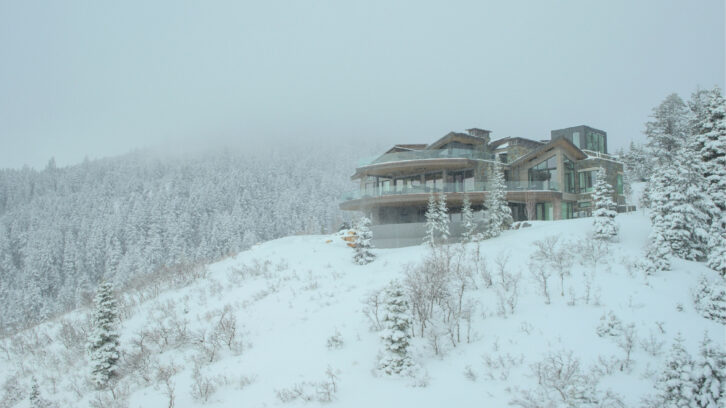Available on HBO and Max internationally, and Sky in the UK, Mountainhead is the feature directorial debut of Succession creator Jesse Armstrong.
The film follows four “tech bros” as they gather for a poker weekend against the backdrop of a rapidly unfolding international crisis.

UNIT Film & TV provided the film’s VFX, while the company’s Dan Coles handled the colour grade.
Coles has worked on a number of HBO shows and previously collaborated with the film’s director of photography, Marcel Zyskind.
“Marcel and I launched straight into calls and emails to discuss the look of Mountainhead,” Coles tells TVBEurope. “We chatted about looks and colour references in film and photography, as well as cameras, lenses, filters, and the tools available in post production that can help to mimic the aesthetics of film.”
The pair shared LUTs during what Coles describes as “an extremely narrow window for camera testing”, which were adjusted and customised in Baselight to create a unique look. “Once approved by Marcel and Jesse Armstrong, this was used for the dailies and gave us a strong starting point for the grade.”
Coles was able to start working on the film as soon as filming was done (the film was completed in just six months). “The basic look was decided here at UNIT and gave us a nice head start when it came to day one of the grade. I was then able to do a technical ‘first pass’ on the whole film in which I would establish the look of each scene and then match the surrounding shots accordingly.
“Then Marcel came in to do his pass on the film—at this point we got into some of the finer detail—subtle colour tweaks, enhancing the images with shapes, adding halation and blur, as well as fine tuning the settings of the livegrain system we used. We then presented the grade to Jesse and HBO.”
Light and shade
Mountainhead is set in the secluded mountain mansion of one of the main characters, with a real 21,000 sq ft mansion that was between owners serving as the main location. One of the biggest challenges facing the filmmakers was the house’s huge windows, which look out onto the snowy mountain of the film’s title. “Early camera tests taught us that we would need to be mindful of the detail coming through the huge windows of the main location,” explains Coles.

“However, when it came to the main shoot, the Alexa 35 in conjunction with our show LUT were able to handle this huge dynamic range in our primary HDR grade. The process of tone mapping to SDR subsequently preserved this information very nicely. Only occasionally did we need to add tiny amounts of diffusion to some of the brightest bits of snow and sun in the background.”
To enhance the film’s cinematic look, cyans and greens were subtly heightened, particularly in the darker shadow areas of the frame. The characters’ clothing also subtly changes over the course of the film. “The use of colour and contrast in the grade reflects the overall shift in story and tone into something darker. Having those splashes of more vibrant colour popping nicely early on in the film helps with this subtle transition.”
Coles has been working with Baselight for over a decade. He says his familiarity with the system enables him to maximise his creativity and consistency when he’s pushed for time during the grading process. “The system is powerful, creative, fast and incredibly flexible,” he adds. “There are countless tools in Baselight that are both useful and invaluable. However, for Mountainhead, we had some fun adding halation and colour into highlights—this was really quite subtle but definitely added to the filmic aesthetic we were hoping to achieve.”
With just eight days to complete the grade for Mountainhead, Coles spent time working on his own and with DoP Zyskind, while Armstrong joined the process at “key stage”.
“The biggest challenge in the grade was (and nearly always is) in matching the different material [which] can be shot across different days, across a variety of different lighting setups or weather conditions,” he states. “Also, in Mountainhead, the spontaneous two-camera shooting style adds so much energy and reality, but in the grade, this requires just a bit more care in balancing to create a seamless experience for the viewer.
“Mountainhead is both uniquely hilarious and scarily relevant,” Coles continues. “The time in which everything was achieved across the production and post production schedule from script to screen is amazing! On behalf of the team at UNIT Film and TV, who also provided a portion of the VFX for the film, we are all immensely proud to have been involved with Jesse Armstrong’s directorial TV movie debut.”







